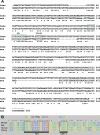Nuclear factor 1 and T-cell factor/LEF recognition elements regulate Pitx2 transcription in pituitary development
- PMID: 17562863
- PMCID: PMC1952127
- DOI: 10.1128/MCB.01848-06
Nuclear factor 1 and T-cell factor/LEF recognition elements regulate Pitx2 transcription in pituitary development
Abstract
Pitx2, a paired-related homeobox gene that is mutated in Rieger syndrome I, is the earliest known marker of oral ectoderm. Pitx2 was previously shown to be required for tooth, palate, and pituitary development in mice; however, the mechanisms regulating Pitx2 transcription in the oral ectoderm are poorly understood. Here we used an in vivo transgenic approach to investigate the mechanisms regulating Pitx2 transcription. We identified a 7-kb fragment that directs LacZ expression in oral ectoderm and in many of its derivatives. Deletion analysis of transgenic embryos reduced this fragment to a 520-bp region that directed LacZ activity to Rathke's pouch. A comparison of the mouse and human sequences revealed a conserved nuclear factor 1 (NF-1) recognition element near a consensus T-cell factor (TCF)/LEF binding site. The mutation of either site individually abolished LacZ activity in transgenic embryos, identifying Pitx2 as a direct target of Wnt signaling in pituitary development. These findings uncover a requirement for NF-1 and TCF factors in Pitx2 transcriptional regulation in the pituitary and provide insight into the mechanisms controlling region-specific transcription in the oral ectoderm and its derivatives.
Figures








References
-
- Amendt, B. A., L. B. Sutherland, E. V. Semina, and A. F. Russo. 1998. The molecular basis of Rieger syndrome. Analysis of Pitx2 homeodomain protein activities. J. Biol. Chem. 273:20066-20072. - PubMed
-
- Barolo, S., and J. W. Posakony. 2002. Three habits of highly effective signaling pathways: principles of transcriptional control by developmental cell signaling. Genes Dev. 16:1167-1181. - PubMed
-
- Belikov, S., P. H. Holmqvist, C. Astrand, and O. Wrange. 2004. Nuclear factor 1 and octamer transcription factor 1 binding preset the chromatin structure of the mouse mammary tumor virus promoter for hormone induction. J. Biol. Chem. 279:49857-49867. - PubMed
Publication types
MeSH terms
Substances
Grants and funding
LinkOut - more resources
Full Text Sources
Molecular Biology Databases
Research Materials
Miscellaneous
